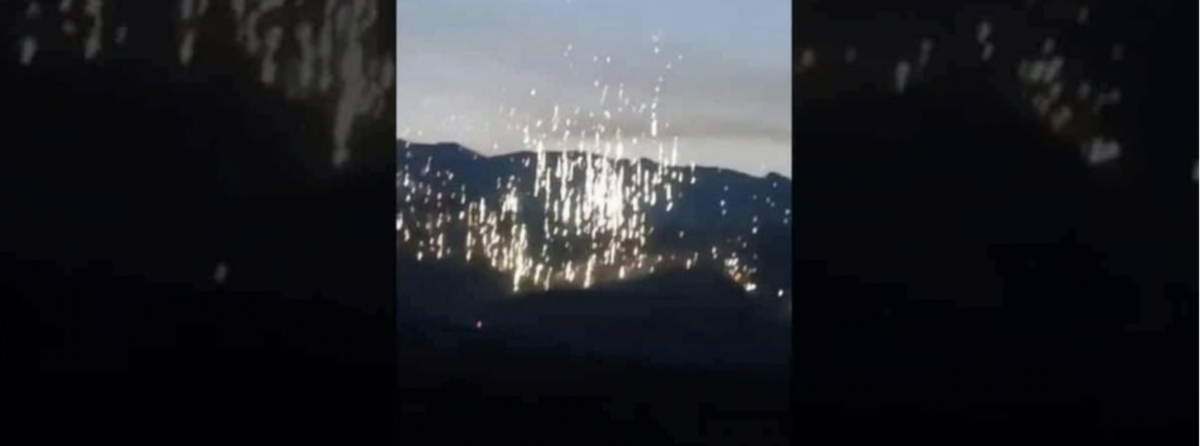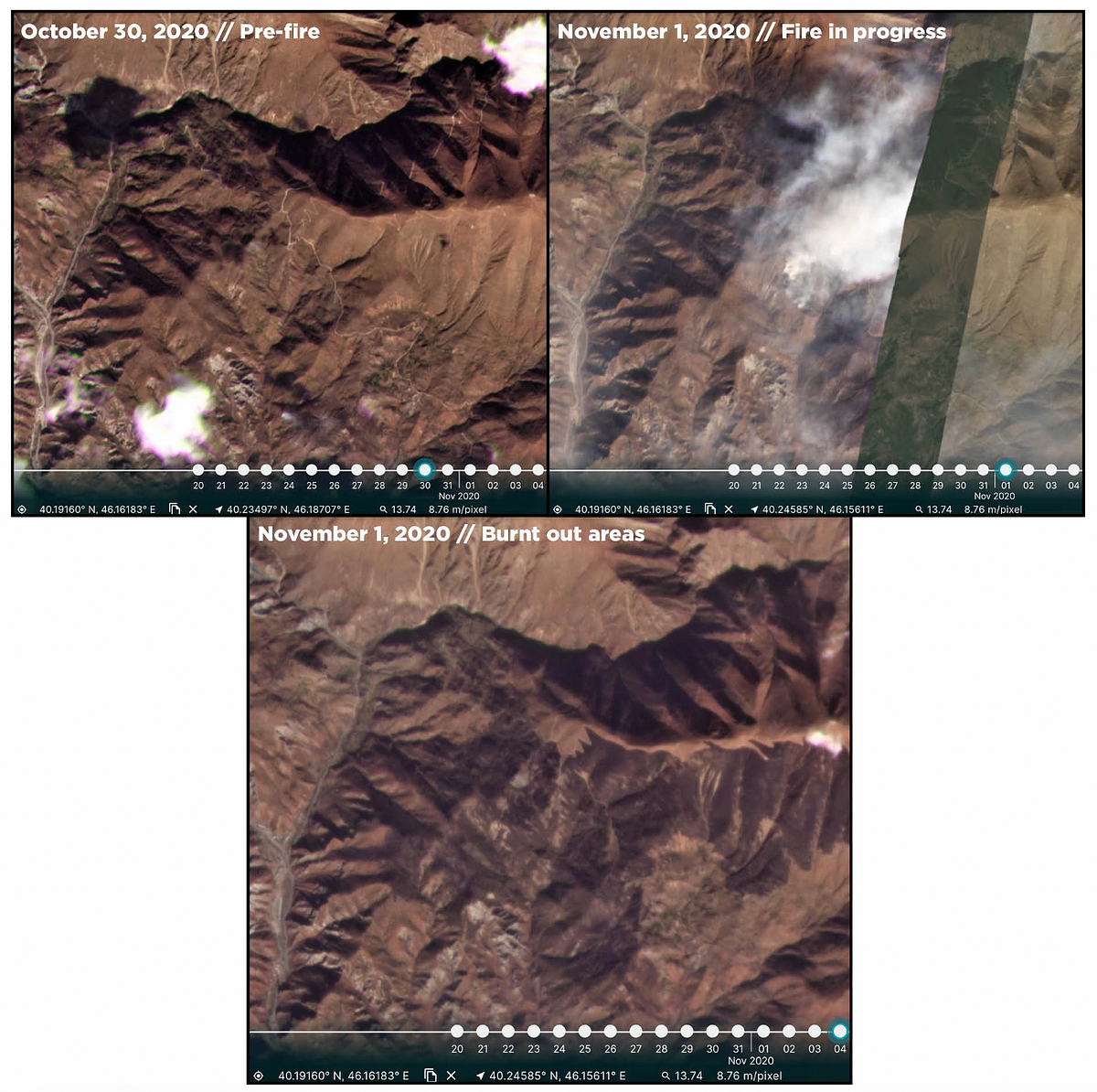Satellite imagery shows environmental damage of reported white phosphorus use in Nagorno Karabakh
Images show extensive burn marks, traces of likely white phosphorous use on forested areas by Azerbaijan
Satellite imagery shows environmental damage of reported white phosphorus use in Nagorno Karabakh
Share this story

Banner: Images show extensive burn marks, traces of likely white phosphorous use on forested areas by Azerbaijan
The Second Karabakh War is now over with a Russia-brokered ceasefire deal. But as the fog of war lifts and both sides assess the full extent of the damage, emerging open-source satellite imagery from the last week of fighting shows the environmental destruction resulting from Azerbaijan’s reported use of white phosphorus munitions on forests in Nagorno-Karabakh.
In early November, videos reportedly showing banned white phosphorus munitions on Armenian-controlled areas in Karabakh started appearing on Twitter and other social media outlets. The imagery did not attract significant attention from international media or international environmental conservation organizations, but Transparency International Armenia issued an Ecocide Alert for the region, condemning the weapons’ use:
The usage of white phosphorus munitions by Azerbaijani forces in those forests will not only destroy valuable ecosystems & habitats and put threatened species at the risk of extinction but will contaminate rivers & underground waters for years, thus turning into a major threat of regional scale for all the people and wildlife living in the region.
Azerbaijan denied reports that it had used the incendiary munitions on Armenian-controlled areas. On Twitter, Hikmet Hajiyev, foreign policy advisor to Azerbaijani President Ilham Aliyev, countered that Armenia previously used white phosphorus munitions on the Azerbaijani-controlled territory of Fizuli. Turkish state outlets made similar claims, but there was no open-source evidence that supported them.
Satellite imagery confirms, however, that large areas of forest in Armenian-controlled territory showed extensive fire damage at the same time as the videos alleging Azerbaijan’s phosphorous munitions use appeared. The targeting of forested areas is a strategy sometimes used to flush combatants from an area or to inflict high-collateral environmental destruction.
A shifting battle
At the end of October, the tide in the Nagorno-Karabakh conflict turned in Azerbaijan’s favor. After a month of gruesome fighting, Azerbaijani forces broke through in several fronts and started making rapid moves towards the capital of the region, Stepanakert. With material support from Turkey and significantly larger military funds relative to Armenia, Azerbaijan benefited from total air superiority, and used advanced drones to its advantage.
But as Azerbaijani forces started making rapid progress into Armenian-defended territories, the terrain became more mountainous and forested. This terrain provided much more suitable defense for Armenian soldiers, who used smaller unit tactics and forest as cover from drone attacks. In response to these challenges, Azerbaijan resorted to indiscriminate tactics, using what appeared to be incendiary munitions to start large forest fires in Armenian-controlled areas. Videos of the reported use of white phosphorous started appearing on social media outlets in early November.
Some videos were filmed by Armenian soldiers as the reported white phosphorus munitions were falling on their defensive positions.
None of the surfaced videos have been filmed in populated areas, suggesting that the primary tactic employed here was to set fire to and destroy forested areas rather than to target civilians.
To confirm use of white phosphorus based solely on visual open-source evidence is difficult, as its visible signatures often match those of other chemicals used in incendiary munitions. The DFRLab has previously reported on phosphorous use in other conflicts, however, particularly in Syria, and the munitions seen in videos of the incident in Nagorno-Karabakh closely resemble other cases of likely use the DFRLab has studied. The bomblets of these munitions usually fall gradually from the sky, producing bright white light and white smoke while burning to the ground.
In previous reports, the DFRLab has noted that the extensive environmental damage of these munitions often appears in satellite imagery after, which in turn can be used to verify their use at a particular instance in time. In the case of Nagorno Karabakh, large burnt fields resembling burn damage from white phosphorous, or a very chemically similar material, were identified in Armenian-controlled territory.
Two visible areas of damage correspond with the timeframe the videos of munitions explosions captured. Both areas have been confirmed to be in the Armenian-controlled areas of Nagorno-Karabakh: Area #1 is northwest of the village of Dadivank, and Area #2 is close to the village of Arpagetik.

Comparison of the satellite images are provided in three frames: pre-fire, during the fire, and the aftermath. In the middle images, large plumes of smoke can be seen devastating the area. In the aftermath, large areas of blackened terrain can be seen, indicating significant environmental damage.


This open-source evidence suggests that Azerbaijan used extreme and indiscriminate tactics against Armenian forces, causing high-collateral damage to the environment. While the direct military value of these tactics is hard to determine, they can work as an effective psychological measure.
Cite this case study:
Lukas Andriukaitis, “Satellite imagery shows environmental damage of reported white phosphorus use in Nagorno Karabakh,” Digital Forensic Research Lab (DFRLab), November 12, 2020, https://dfrlab.org/2020/11/12/satellite-imagery-shows-environmental-damage-of-reported-white-phosphorus-use-in-nagorno-karabakh/.

